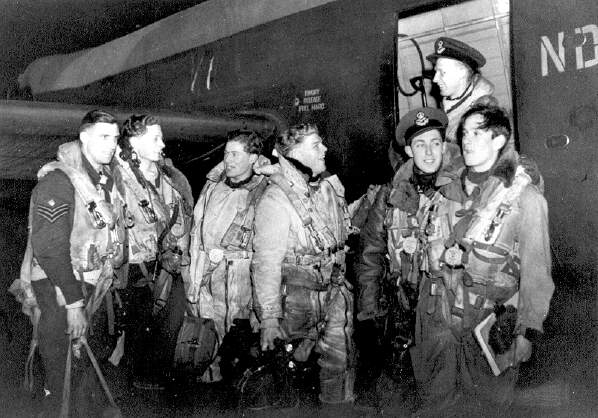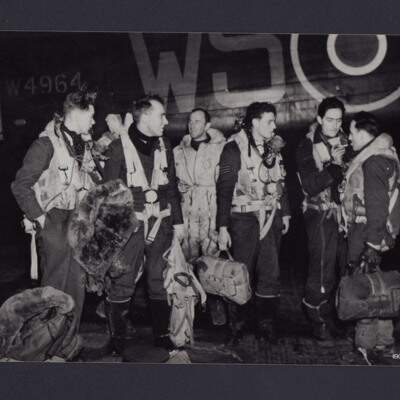Can anyone confirm this is the flying gear that Crews flying in Lancasters would have worn?

I’ve been asked this question and I want to make absolutely sure before I say yes as this is for a massive project, literally. Those who were at Telford last year might have seen what this might be for. 
2 Likes
Hi Mal,
I think it depends on which position they crew, Pilot, Mid upper gunner etc. Also winter / summer or even personal preference. Say that though I would think the tail end Charlie would rap up warm as they were open to the elements.
In the photo below you can see one crewman in RAF blues.



Although it’s difficult to tell and I can’t get the picture any bigger, I think that the flying gear in the colour photo is actually early war fighter pilot gear. The “seat type” parachute pack was meant to fit in a fighter seat, the pilot literally sat on his parachute. Lancaster crews had a different type completely. The flight suit also looks like pre-war issue summer wear. Bomber crews were flying at high altitude and usually wore fleece lined leather flight suits with electrical heating elements woven in. Many people’s views of RAF flying gear are influenced by “The Dambusters” film, but this raid was flown at low level.
Thanks mate. I can’t imagine flying at altitude wearing blues, no matter the position! Yes Hugo asked me this question. 
Thanks for that. I think that you could be right. Certainly about the seat parachute.
Here’s a page copied from an old WW2 weekly encyclopedia, this volume dealt with uniforms. The caption dates the picture as 1939, but this flying suit was worn by bomber crews throughout the war with minor changes. Note that the left hand figure is carrying his parachute. It wasn’t worn during the flight, it had to be retrieved when needed and clipped onto the front of the flying suit. Note also the “Harnisuit” on the Whitley crewman. I can’t be sure, but it’s possible some of the figures in Littorio’s pictures are wearing it. Ignore caption 73 and 74, they refer to pictures on the opposite page which are of fighter pilots. I believe these and other pictures in the book are taken from photographs (caption 74 refers to a specific person) so they should be accurate. There was an additional issue of flying boots, the 1943 pattern, which had leather feet, but canvas shanks which could be cut off with an attached knife, to convert them into a semblance of civilian shoes, to aid escape and evasion.
Generally the aircraft were unheated, the rear turret being particularly cold due to some squadrons removing the centre Plexiglass portion to improve vision, but there was a heater under the Wireless Operator and Navigator (?), due to them having difficulty performing their tasks in heavy gloves. This had the opposite effect of baking these crew members!
A personal memory - my Dad was a radar fitter in Costal Command, but he had to fly air tests on the equipment so had flying gear. He swopped his Irvin jacket with an American, because the US jacket fitted better and was more comfortable! He painted his squadron emblem on the chest. I still wear one of his old Tootal “Pilot Officer Prawn” scarfs on my motorbike.
Thank you very much for that, excellent. 

![]()



